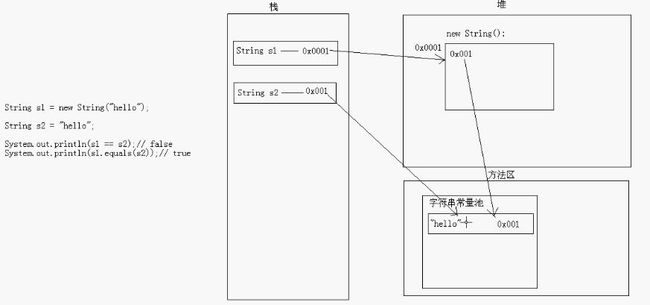day12-----------常见对象(传智视频)
package cn.itcast_03;
import java.util.Scanner;
/*
* 常用的两个方法:
* public int nextInt():获取一个int类型的值
* public String nextLine():获取一个String类型的值
*
* 出现问题了:
* 先获取一个数值,在获取一个字符串,会出现问题。
* 主要原因:就是那个换行符号的问题。
* 如何解决呢?
* A:先获取一个数值后,在创建一个新的键盘录入对象获取字符串。
* B:把所有的数据都先按照字符串获取,然后要什么,你就对应的转换为什么。
*/
public class ScannerDemo {
public static void main(String[] args) {
// 创建对象
Scanner sc = new Scanner(System.in);
// 获取两个int类型的值
// int a = sc.nextInt();
// int b = sc.nextInt();
// System.out.println("a:" + a + ",b:" + b);
// System.out.println("-------------------");
// 获取两个String类型的值
// String s1 = sc.nextLine();
// String s2 = sc.nextLine();
// System.out.println("s1:" + s1 + ",s2:" + s2);
// System.out.println("-------------------");
// 先获取一个字符串,在获取一个int值
// String s1 = sc.nextLine();
// int b = sc.nextInt();
// System.out.println("s1:" + s1 + ",b:" + b);
// System.out.println("-------------------");
// 先获取一个int值,在获取一个字符串
// int a = sc.nextInt();
// String s2 = sc.nextLine();
// System.out.println("a:" + a + ",s2:" + s2);
// System.out.println("-------------------");
int a = sc.nextInt();
Scanner sc2 = new Scanner(System.in);
String s = sc2.nextLine();
System.out.println("a:" + a + ",s:" + s);
}
}
package cn.itcast_01;
/*
* 字符串:就是由多个字符组成的一串数据。也可以看成是一个字符数组。
* 通过查看API,我们可以知道
* A:字符串字面值"abc"也可以看成是一个字符串对象。
* B:字符串是常量,一旦被赋值,就不能被改变。
*
* 构造方法:
* public String():空构造
* public String(byte[] bytes):把字节数组转成字符串
* public String(byte[] bytes,int index,int length):把字节数组的一部分转成字符串
* public String(char[] value):把字符数组转成字符串
* public String(char[] value,int index,int count):把字符数组的一部分转成字符串
* public String(String original):把字符串常量值转成字符串
*
* 字符串的方法:
* public int length():返回此字符串的长度。
*/
public class StringDemo {
public static void main(String[] args) {
// public String():空构造
String s1 = new String();
System.out.println("s1:" + s1);
System.out.println("s1.length():" + s1.length());
System.out.println("--------------------------");
// public String(byte[] bytes):把字节数组转成字符串
byte[] bys = { 97, 98, 99, 100, 101 };
String s2 = new String(bys);
System.out.println("s2:" + s2);
System.out.println("s2.length():" + s2.length());
System.out.println("--------------------------");
// public String(byte[] bytes,int index,int length):把字节数组的一部分转成字符串
// 我想得到字符串"bcd"
String s3 = new String(bys, 1, 3);
System.out.println("s3:" + s3);
System.out.println("s3.length():" + s3.length());
System.out.println("--------------------------");
// public String(char[] value):把字符数组转成字符串
char[] chs = { 'a', 'b', 'c', 'd', 'e', '爱', '林', '亲' };
String s4 = new String(chs);
System.out.println("s4:" + s4);
System.out.println("s4.length():" + s4.length());
System.out.println("--------------------------");
// public String(char[] value,int index,int count):把字符数组的一部分转成字符串
String s5 = new String(chs, 2, 4);
System.out.println("s5:" + s5);
System.out.println("s5.length():" + s5.length());
System.out.println("--------------------------");
//public String(String original):把字符串常量值转成字符串
String s6 = new String("abcde");
System.out.println("s6:" + s6);
System.out.println("s6.length():" + s6.length());
System.out.println("--------------------------");
//字符串字面值"abc"也可以看成是一个字符串对象。
String s7 = "abcde";
System.out.println("s7:"+s7);
System.out.println("s7.length():"+s7.length());
}
}
值不能被改变,但是引用可以改变
/*
* String s = new String(“hello”)和String s = “hello”;的区别?
* 有。前者会创建2个对象,后者创建1个对象。
*
* ==:比较引用类型比较的是地址值是否相同
* equals:比较引用类型默认也是比较地址值是否相同,而String类重写了equals()方法,比较的是内容是否相同。
*/
public class StringDemo2 {
public static void main(String[] args) {
String s1 = new String("hello");
String s2 = "hello";
System.out.println(s1 == s2);// false
System.out.println(s1.equals(s2));// true
}
}
package cn.itcast_02;
/*
* 看程序写结果
* 字符串如果是变量相加,先开空间,在拼接。
* 字符串如果是常量相加,是先加,然后在常量池找,如果有就直接返回,否则,就创建。
"=="比较的是地址,"equals"比较的是内容
*/
public class StringDemo4 {
public static void main(String[] args) {
String s1 = "hello";
String s2 = "world";
String s3 = "helloworld";
System.out.println(s3 == s1 + s2);// false
System.out.println(s3.equals((s1 + s2)));// true
System.out.println(s3 == "hello" + "world");// false 这个我们错了,应该是true
System.out.println(s3.equals("hello" + "world"));// true
// 通过反编译看源码,我们知道这里已经做好了处理。
// System.out.println(s3 == "helloworld");
// System.out.println(s3.equals("helloworld"));
}
}
/* * String类的获取功能 * int length():获取字符串的长度。 * char charAt(int index):获取指定索引位置的字符 * int indexOf(int ch):返回指定字符在此字符串中第一次出现处的索引。 * 为什么这里是int类型,而不是char类型? * 原因是:'a'和97其实都可以代表'a' * int indexOf(String str):返回指定字符串在此字符串中第一次出现处的索引。 * int indexOf(int ch,int fromIndex):返回指定字符在此字符串中从指定位置后第一次出现处的索引。 * int indexOf(String str,int fromIndex):返回指定字符串在此字符串中从指定位置后第一次出现处的索引。 * String substring(int start):从指定位置开始截取字符串,默认到末尾。 * String substring(int start,int end):从指定位置开始到指定位置结束截取字符串。 */
package cn.itcast_05;
/*
* String的转换功能:
* byte[] getBytes():把字符串转换为字节数组。
* char[] toCharArray():把字符串转换为字符数组。
* static String valueOf(char[] chs):把字符数组转成字符串。
* static String valueOf(int i):把int类型的数据转成字符串。
* 注意:String类的valueOf方法可以把任意类型的数据转成字符串。
* String toLowerCase():把字符串转成小写。
* String toUpperCase():把字符串转成大写。
* String concat(String str):把字符串拼接。
*/
public class StringDemo {
public static void main(String[] args) {
// 定义一个字符串对象
String s = "JavaSE";
// byte[] getBytes():把字符串转换为字节数组。
byte[] bys = s.getBytes();
for (int x = 0; x < bys.length; x++) {
System.out.println(bys[x]);
}
System.out.println("----------------");
// char[] toCharArray():把字符串转换为字符数组。
char[] chs = s.toCharArray();
for (int x = 0; x < chs.length; x++) {
System.out.println(chs[x]);
}
System.out.println("----------------");
// static String valueOf(char[] chs):把字符数组转成字符串。
String ss = String.valueOf(chs);
System.out.println(ss);
System.out.println("----------------");
// static String valueOf(int i):把int类型的数据转成字符串。
int i = 100;
String sss = String.valueOf(i);
System.out.println(sss);
System.out.println("----------------");
// String toLowerCase():把字符串转成小写。
System.out.println("toLowerCase:" + s.toLowerCase());
System.out.println("s:" + s);
// System.out.println("----------------");
// String toUpperCase():把字符串转成大写。
System.out.println("toUpperCase:" + s.toUpperCase());
System.out.println("----------------");
// String concat(String str):把字符串拼接。
String s1 = "hello";
String s2 = "world";
String s3 = s1 + s2;
String s4 = s1.concat(s2);
System.out.println("s3:"+s3);
System.out.println("s4:"+s4);
}
}
/* * String类的其他功能: * * 替换功能: * String replace(char old,char new) * String replace(String old,String new) * * 去除字符串两端空格 * String trim() * * 按字典顺序比较两个字符串 * int compareTo(String str) * int compareToIgnoreCase(String str) */
debug 中 F5 进入子函数

